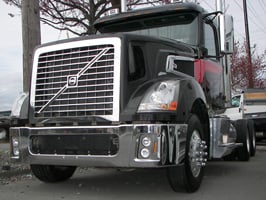
Bad ground is the general term used to describe a ground wire or circuit that has more resistance than normal due to corrosion (oxidation) in the wiring harness or pin connections. This corrosion is caused by a break in the wire's insulation or faulty connector seals, which leads to an even bigger issue on today's trucks, especially when everything is computer controlled or monitored with an electronic control unit (ECU).
A typical Volvo truck has an ECU for every major component.
- Engine
- Transmission
- Anti-lock braking system (ABS)
- Vehicle ECU
- Instrument cluster
- Lighting control module (LCM)
- Body builder control module
- Supplemental restraint systems (SRS)
Sometimes the problems are there after 250,000 miles, sometimes they come straight from the factory with 30 to 300 miles on the truck when the problems arise. The wires are like little pipes and if there is a break in the wire insulation or a faulty seal, water gets in and travels down the wire "infecting" everything in its path. If the problem is up higher in the harness, gravity will work to its benefit.
Seeing the grounding problems
Grounding problems can be caused by a myriad of issues, including:
- improperly installed aftermarket equipment,
- an unsecured, overly secured, or stretched harness,
- vibration of the diesel engine,
- tightly installed zip ties (from the factory),
- corrosion,
- resistance, or
- ECU communications.
Corrosion issues are easy to spot with either a visible hint of light green or a light film on pin connections. Grounding issues can be identified in the high resistance values between the truck cab and the frame and between the frame and the engine. Anything over .3 ohms could cause problems.
Communication issues between ECUs makes diagnosing problems more complex. There are two different data links throughout the truck: the J1939 control link and the J1587/1708 info link. Think of the data links like a phone wire connected to all the ECUs in the truck. The wire sends information back to the instrument cluster (e.g., diagnostic trouble codes (DTC), vehicle speed, ABS wheel speed, engine pressures, temperatures). The J1939 control link should have a sustained reading of 60 ohms—if not, then there is a problem in the circuit or terminating resistor.
Troubleshooting ground issues
As for troubleshooting electrical ground problems, a good source of information is the truck’s wiring schematic, which shows wire/circuit numbers, connector locations, pin locations, and wire colors. The cluster in the latest model of truck shows the DTCs and other specifics to help troubleshoot the problem in depth.
For example, an electrical fault or mechanical fault, voltage high, voltage low, circuit shorted high, circuit shorted low, data erratic, or communication error are all descriptions linked to certain fault codes, which in turn makes it easier for diagnostics to be performed. Those codes also help determine which function to use on a digital multimeter when looking for that problem.
The grounding problems I see the most are high resistance values between the truck cab and the frame and between the frame and the engine. Anything over .3 ohms is going to cause problems.
Most problems can be determined by process of elimination. Start by checking fuses—if the fuses check out, then check what the wire is controlling (e.g., light, sensor, motor). Next, check the circuit to make sure the wires are not damaged and have good continuity. (There are miles of wires and plenty of potential problems areas.) If this area checks out, move on to the beginning of the circuit (e.g., ECU, switch).
Sometimes the problem can’t be traced or duplicated, which can be frustrating. Variables that affect troubleshooting "invisible" problems include temperature, pressure, and vibration. Some faults can be found by connecting a digital multimeter and wiggling the harness to see if there is a jump, dip, or complete loss in voltage, the latter indicating an open circuit.